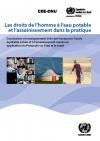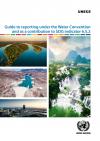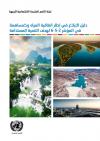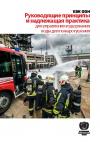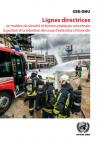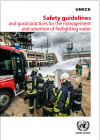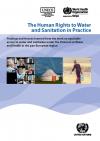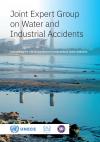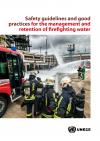Publications
Displaying Results 61 - 80 of 595
- Français
Le Protocole sur l’eau et la santé est un instrument juridiquement contraignant qui a pour objet d’assurer à tous un approvisionnement suffisant en eau potable salubre et en assainissement, et, de protéger efficacement les ressources en eau dans la région pan-européenne. Dans la poursuite de ces objectifs, il accorde une attention particulière à garantir un accès équitable aux services d’eau et d
- English
There is an increasing recognition that energy-related objectives can be achieved more effectively through integrated and consultative planning, in synergy with environmental and other sectoral objectives, notably those of the water and agricultural sectors. A series of intersectoral “nexus” assessments under the Convention on the Protection and Use of
- Français
L’introduction d’un mécanisme de suivi par le biais d’établissement de rapports au titre de la Convention sur l’eau et dans le cadre de l’adoption du cadre des ODD (indicateur 6.5.2 des ODD) marque une étape importante dans le soutien à la coopération transfrontière sur l’eau. Le présent Guide pour l’établissement de rapports au titre de la Convention sur l’eau et en contribution à l’indicateur 6
- Pусский
The introduction of a reporting monitoring mechanism under the Water Convention and the adoption of the SDG framework (SDG indicator 6.5.2) mark an important step in supporting transboundary water cooperation. This Guide to reporting under the Water Convention and as a contribution to SDG indicator 6.5.2 was developed as a result of a review of the first reporting on SDG indicator 6.5.2 and under
- English
The introduction of a reporting monitoring mechanism under the Water Convention and the adoption of the SDG framework (SDG indicator 6.5.2) mark an important step in supporting transboundary water cooperation. This Guide to reporting under the Water Convention and as a contribution to SDG indicator 6.5.2 was developed as a result of a review of the first reporting on SDG indicator 6.5.2 and under
- العربية
The introduction of a reporting monitoring mechanism under the Water Convention and the adoption of the SDG framework (SDG indicator 6.5.2) mark an important step in supporting transboundary water cooperation. This Guide to reporting under the Water Convention and as a contribution to SDG indicator 6.5.2 was developed as a result of a review of the first reporting on SDG indicator 6.5.2 and under
- Pусский
These safety guidelines and good practices have been developed to support governments, competent authorities and operators in minimizing the risk of fire and safely retaining firefighting water. They are intended to enhance existing practices and promote harmonized safety standards for firefighting water management and retention, in order to prevent accidental pollution of soil and water,
- Français
These safety guidelines and good practices have been developed to support governments, competent authorities and operators in minimizing the risk of fire and safely retaining firefighting water. They are intended to enhance existing practices and promote harmonized safety standards for firefighting water management and retention, in order to prevent accidental pollution of soil and water,
- English
These safety guidelines and good practices have been developed to support governments, competent authorities and operators in minimizing the risk of fire and safely retaining firefighting water. They are intended to enhance existing practices and promote harmonized safety standards for firefighting water management and retention, in order to prevent accidental pollution of soil and water,
- English
Parties, beneficiary countries of the Assistance and Cooperation Programme and other countries wishing to implement the UNECE Convention on the Transboundary Effects of Industrial Accidents sometimes face challenges in the interpretation of its provisions. Shedding light on the basic requirements of the Convention, this Guide offers a practical explanation of what compliance with this legal
- English
These safety guidelines and good practices have been developed to support governments, competent authorities and operators in minimizing the risk of fire and safely retaining firefighting water. They are intended to enhance existing practices and promote harmonized safety standards for firefighting water management and retention, in order to prevent accidental pollution of soil and water,
- English
The Protocol on Water and Health aims at achieving an adequate supply of safe drinking water and sanitation for everyone and effectively protecting water resources in the pan-European region. In pursuing such aims, it gives special consideration to ensure equitable access to water and sanitation services “for all members of the population, especially those who suffer a disadvantage or social
- English
The Joint Expert Group was established in 1998 to work on issues related to the prevention of accidental water pollution, in the context of the Convention on the Protection and Use of Transboundary Watercourses and International Lakes (Water Convention) and the Convention on the Transboundary Effects of Industrial Accidents (Industrial Accidents Convention), both serviced by UNECE. These
- English
This postcard provides a brief summary of the UNECE Safety Guidelines and Good Practices for Tailings Management Facilities which have been developed by the Joint Expert Group on Water and Industrial Accidents in cooperation with experts on tailings safety and UNECE. The Guidelines provide a set of principles, technical recommendations and good practices that can assist governments and
- English
This postcard provides a brief summary of the UNECE Safety Guidelines and Good Practices for Pipelines which have been developed by the Joint Expert Group on Water and Industrial Accidents in cooperation with experts on pipelines safety and UNECE. The Guidelines contain key principles and recommendations for the safe transport of hazardous substances by pipelines. They include specific
- English
This postcard provides a brief summary of the UNECE Safety Guidelines and Good Practices for Oil Terminals which have been developed by the Joint Expert Group on Water and Industrial Accidents in cooperation with experts on oil terminals safety and UNECE. The Guidelines provide a set of principles, recommendations and technical recommendations (including for design, planning, procurement,
- English
This postcard provides a brief summary of the UNECE Safety Guidelines and Good Practices for the Management and Retention of Firefighting Water which have been developed by the Joint Expert Group on Water and Industrial Accidents in cooperation with experts on firefighting water retention and UNECE. The Guidelines aim to support governments, competent authorities and operators by enhancing
- Pусский
This postcard provides a brief summary of the UNECE Safety Guidelines and Good Practices for the Management and Retention of Firefighting Water which have been developed by the Joint Expert Group on Water and Industrial Accidents in cooperation with experts on firefighting water retention and UNECE. The Guidelines aim to support governments, competent authorities and operators by enhancing
- Français
This postcard provides a brief summary of the UNECE Safety Guidelines and Good Practices for the Management and Retention of Firefighting Water which have been developed by the Joint Expert Group on Water and Industrial Accidents in cooperation with experts on firefighting water retention and UNECE. The Guidelines aim to support governments, competent authorities and operators by enhancing
- English
This postcard provides a brief summary of the UNECE Safety Guidelines and Good Practices for the Management and Retention of Firefighting Water which have been developed by the Joint Expert Group on Water and Industrial Accidents in cooperation with experts on firefighting water retention and UNECE. The Guidelines aim to support governments, competent authorities and operators by enhancing


